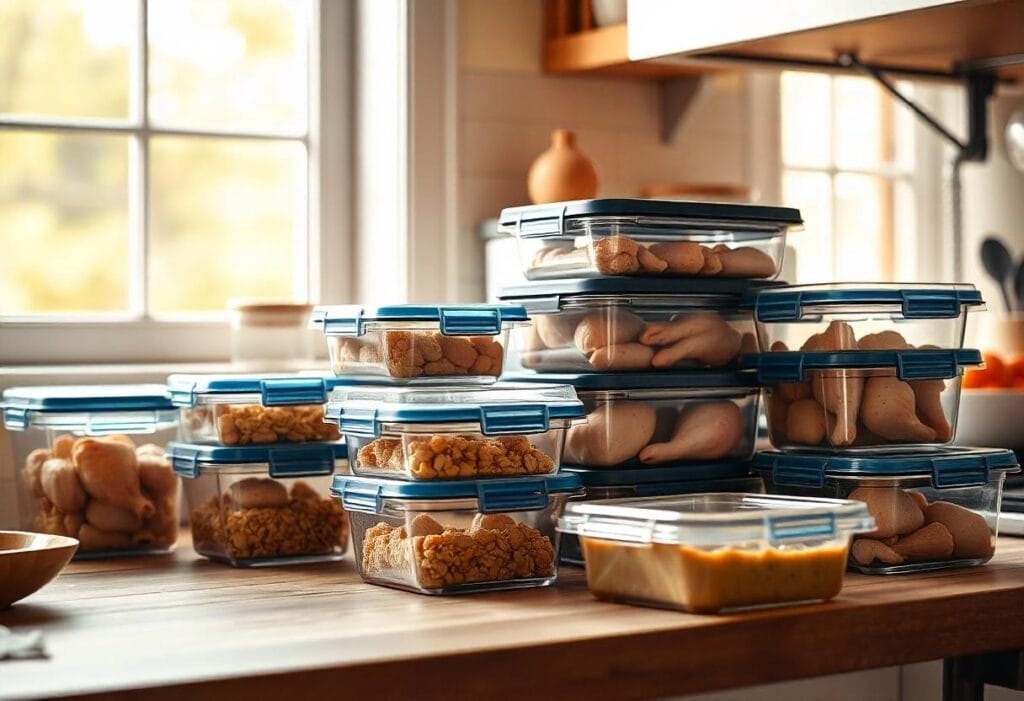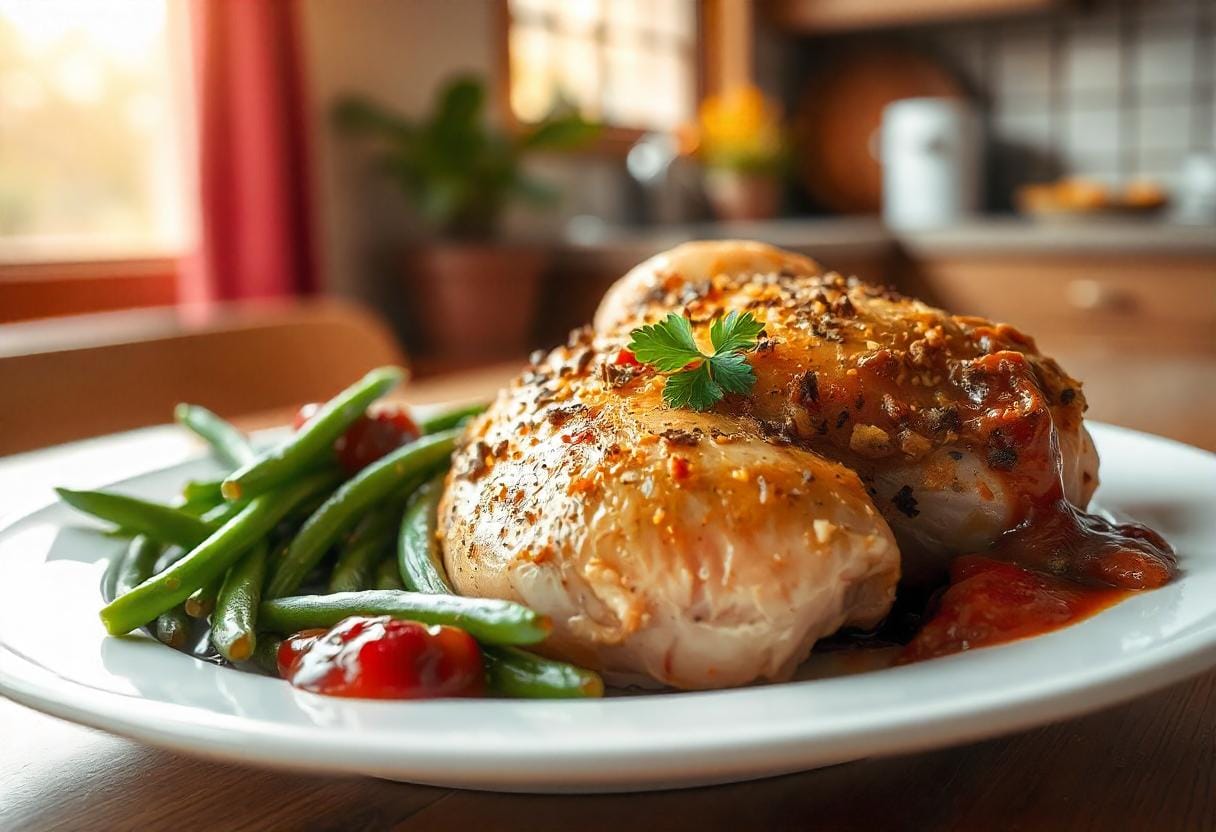Table of Contents
If you’ve ever wondered about the chicken and dressing shelf life, you’re not alone! Leftovers like chicken and dressing are a staple in many households, especially after family gatherings or holidays. But how long can you safely store and eat them? In this article, we’ll dive into the best ways to store your chicken and dressing, how to know when they’ve gone bad, and how long you can keep them before they become unsafe to eat. 🍗🍞
Knowing how long you can safely keep chicken and dressing is not just about taste—it’s also a matter of food safety. If not stored properly, leftovers can become a breeding ground for bacteria, which could lead to foodborne illnesses. So, let’s explore how to store your leftover chicken and dressing, how long they last, and how to tell if they’re still safe to eat. It’s all about keeping your meals both delicious and safe! 🥡
Introduction to Chicken and Dressing Leftovers
We all love the comforting warmth of a home-cooked meal, and chicken and dressing is no exception. After a hearty holiday meal, you’re left with delicious leftovers. But how long can you eat chicken and dressing without worrying about food safety?
Not sure about the difference between stuffing and dressing?
Find out in our Stuffing vs. Dressing Guide!
After a hearty holiday meal, you’re left with delicious leftovers. But how long can you eat chicken and dressing without worrying about food safety? Proper storage is key. This article will guide you on how long you can keep chicken and dressing in the fridge or freezer and give you tips on how to safely store and reheat them.
Why Knowing How Long Chicken and Dressing Lasts Is Important
Leftovers are a fantastic way to stretch your meals, but they do have a limited shelf life. Knowing how long you can eat chicken and dressing ensures that you won’t accidentally consume something that’s gone bad and could cause foodborne illness. The question isn’t just about how tasty your chicken and dressing are, but also about their safety. So, let’s break down the storage rules!
While chicken is a lean protein that can spoil quickly, dressing, typically made with bread and broth, is also prone to bacteria growth when not stored correctly. So, the golden rule here is: store them properly and eat them within a reasonable time.
The Factors That Affect the Shelf Life of Chicken and Dressing
Several factors influence how long your leftover chicken and dressing will last, including:
- Storage temperature: The fridge should be kept at 40°F (4°C) or lower. Anything warmer can encourage bacteria to grow.
- The initial freshness: If the chicken and dressing were fresh to begin with, they have a better chance of lasting a bit longer.
- How long the food was left at room temperature: Never leave leftovers out at room temperature for more than two hours. Bacteria love warm environments!
- Ingredients: The type of dressing can affect its shelf life. For example, if your dressing contains sausage or oysters, it should be eaten sooner than simple bread dressing.
The Best Practices for Storing Chicken and Dressing
Proper storage is key to extending the shelf life of your leftovers. Cooling, sealing, and refrigerating them correctly will ensure they remain safe to eat.
Need a delicious recipe for homemade chicken and dressing?
Try our Ultimate Chicken and Dressing Recipe for a classic Southern favorite!

How to Properly Store Leftover Chicken and Dressing
The first step to extending the life of your leftovers is ensuring that they’re stored properly. Here’s how:
- Cool the food quickly: Don’t leave chicken and dressing on the counter for too long. After eating, put the leftovers in the fridge as soon as possible. You should aim to store them within two hours of the meal.
- Use airtight containers: To prevent air from getting in and drying out the chicken and dressing, place them in airtight containers. These help keep the food fresh and prevent it from absorbing odors from other items in the fridge.
- Separate portions: If you have a lot of leftovers, consider dividing the chicken and dressing into smaller portions before storing them. This makes it easier to reheat just the amount you need without exposing the entire batch to heat multiple times.
- Label and date: When you store leftovers, it’s easy to forget when you put them in the fridge. So, label your containers with the date. This way, you can keep track of how long they’ve been in there.
Using Airtight Containers for Maximum Freshness
Using airtight containers is one of the most effective ways to preserve leftovers. These containers prevent air from drying out your chicken and dressing and also help keep any bacteria or germs from contaminating your food. When the containers are sealed tightly, the food stays fresher for longer.
Pro Tip: If you’re using plastic wrap or foil, make sure the food is tightly wrapped. Plastic storage bags can also work, but glass containers tend to keep the food fresher for longer due to their airtight seals.
How Long Can You Keep Chicken and Dressing in the Fridge?
According to USDA guidelines, cooked chicken and dressing can be safely stored in the refrigerator for 3 to 4 days.
Wondering how long other Thanksgiving leftovers last?
Check out our Guide to Leftover Chicken and Dressing Storage!
The General Guidelines for Refrigerating Chicken and Dressing
As a general rule:
- Cooked chicken lasts in the fridge for about 3-4 days.
- Dressing can last 3-4 days as well, as long as it’s stored properly.
These are the maximum times you should keep your leftovers in the fridge. The key here is to use your senses. If the chicken or dressing has an off smell or the texture has changed, it’s time to toss it.
Block Quote:
« The USDA recommends that cooked leftovers, including chicken and dressing, be consumed within 3 to 4 days to prevent foodborne illnesses. » 🍗
How to Tell if Your Leftovers Are Still Safe to Eat
Even within the recommended timeframe, always check for signs of spoilage before eating leftover chicken and dressing.
Want to know how long dressing lasts on its own?
Read our Dressing Storage and Freshness Guide for expert tips!
- Smell: If it smells sour or « off, » it’s time to throw it out. Both chicken and dressing can develop a funky odor as bacteria start to grow.
- Texture: If the chicken looks slimy or the dressing is overly mushy (more than usual), it’s probably not safe anymore.
- Color: If you notice any color changes—like the chicken turning gray or the dressing looking moldy—don’t risk it. It’s best to toss it.
Understanding Expiration Dates and Best-By Dates
While chicken and dressing are unlikely to have expiration dates (since they’re homemade), many store-bought items like broth and spices may have a best-by date. Keep an eye on these dates, especially for perishable ingredients used in your dressing.
How Long Can Chicken and Dressing Be Frozen?
Freezing is a great long-term storage solution, keeping chicken and dressing safe for 1-2 months while maintaining flavor and texture.
Want to learn how to freeze dressing properly?
Read our Ultimate Dressing Storage Guide for step-by-step instructions!

Freezing Chicken and Dressing for Long-Term Storage
Freezing is a great option for preserving leftovers when you don’t want to eat them right away. Here’s how you can freeze them safely:
- Cool before freezing: Just like in the fridge, you want to cool the chicken and dressing before freezing them. If you freeze them while still warm, it can raise the temperature in the freezer and cause freezer burn.
- Use freezer-safe containers: Store your chicken and dressing in freezer-safe bags or airtight containers to prevent air exposure and keep the food fresh. When using freezer bags, try to remove as much air as possible.
The Right Way to Freeze Chicken and Dressing for Optimal Quality
If stored properly, chicken and dressing can last in the freezer for 1-2 months without losing quality. Beyond this period, the taste and texture may degrade. If you plan to freeze them, make sure to use them within this time for the best flavor and texture.
Pro Tip: Label the containers with the date so you know when they were frozen. It’s easy to forget after a few weeks!
Signs That Chicken and Dressing Have Gone Bad
To determine if your leftovers have exceeded their chicken and dressing shelf life, check for signs like an off smell, mold, or unusual texture
How to Spot Spoiled Chicken and Dressing by Smell, Texture, and Appearance
As mentioned earlier, use your senses to check if the chicken and dressing have gone bad:
- Smell: A sour, musty, or rancid smell is a surefire sign the food is spoiled.
- Texture: If the chicken becomes slimy or the dressing becomes too watery or moldy, it’s time to say goodbye to those leftovers.
- Color: If the chicken has changed color (e.g., turning a grayish color), or if you spot mold on the dressing, dispose of it immediately.
How Long Can Chicken and Dressing Be Frozen?
Freezing leftovers is a great way to extend their shelf life. If you’re not able to eat your chicken and dressing within a few days, freezing them is the best way to save them for later. Let’s dive deeper into how long chicken and dressing can be kept in the freezer and how to properly store them.
Freezing Chicken and Dressing for Long-Term Storage
Freezing is one of the best ways to preserve chicken and dressing if you don’t plan to eat them right away. This method allows you to store them for months, keeping the flavors intact for when you’re ready to enjoy them again. Here’s how to properly freeze chicken and dressing:
- Cool Them First: After cooking, make sure to allow the chicken and dressing to cool completely before freezing. Putting hot food in the freezer can raise the temperature and affect the overall quality of the food.
- Separate the Portions: Consider dividing the chicken and dressing into individual or meal-sized portions before freezing. This makes it easier to reheat just what you need without defrosting the entire batch.
- Use Proper Freezer Containers: Make sure you use freezer-safe containers or ziplock freezer bags to store your leftovers. These options will help prevent air from getting in, which can cause freezer burn.
- Label and Date: Always label your containers with the date you froze them. This will help you keep track of how long they’ve been in the freezer and ensure that you use them within the recommended time frame.
Pro Tip: Try to freeze your chicken and dressing within two hours of cooling to ensure food safety and preserve freshness.
The Right Way to Freeze Chicken and Dressing for Optimal Quality
Frozen chicken and dressing will stay safe for months, but for optimal taste and texture, it’s best to consume them within 1-2 months. After this time, the flavor and quality may start to degrade.
How to Prevent Freezer Burn: If you’re using freezer bags, try to remove as much air as possible. The less air in contact with the food, the better the preservation. If you’re using containers, make sure the lids are sealed tightly.
Reheating Frozen Chicken and Dressing: The best way to reheat frozen chicken and dressing is in the oven or microwave. Make sure to thaw them properly in the fridge overnight, or use the microwave’s defrost setting to avoid cooking them from frozen, which can affect the texture.
Signs That Chicken and Dressing Have Gone Bad
No one wants to risk eating spoiled food, especially when it comes to leftovers. Luckily, it’s easy to spot when chicken and dressing have gone bad. Let’s go over the signs you need to look for.
How to Spot Spoiled Chicken and Dressing by Smell, Texture, and Appearance
When it comes to leftovers, your senses—particularly smell, texture, and sight—are your best tools for determining if the food is still good.
- Smell: If your chicken has an off or sour smell, it’s time to toss it. Chicken should have a mild, savory smell when fresh, but if it starts to turn, it will develop a foul odor that you can’t ignore.
- Texture: Slimy chicken or mushy dressing is a sign that the food has gone bad. If the chicken feels slimy to the touch, discard it. If the dressing is watery or overly soft, it might also have spoiled.
- Appearance: If you see any mold, discoloration, or a change in color—like grayish or yellow chicken—it’s best to throw it away. Similarly, if your dressing has developed spots or a funky appearance, don’t risk eating it.
It’s important to note that leftovers should never be kept for too long, even if they look okay. Always follow the recommended storage times.
Reheating Tips: How to Safely Reheat Chicken and Dressing
Once your leftovers are safely stored, reheating them properly ensures that they stay tasty and safe to eat. The key is to avoid drying them out or letting them sit at unsafe temperatures.
The Best Methods for Reheating Chicken and Dressing Without Drying It Out
When reheating your chicken and dressing, there are a few things to keep in mind to avoid making the food dry, tough, or overcooked.
- Oven Reheating: The best method for reheating chicken and dressing is using the oven. Preheat your oven to 350°F (175°C). Place the chicken and dressing in an oven-safe dish, cover it with foil to prevent moisture loss, and heat it for 15-20 minutes. If you want the top of the dressing crispy, uncover it during the last 5 minutes of baking.
- Microwave Reheating: For quicker reheating, the microwave works well. Place the chicken and dressing in a microwave-safe dish, and cover it with a damp paper towel to keep it from drying out. Reheat in short bursts of 1-2 minutes to make sure it heats evenly. Stir the dressing halfway through to avoid cold spots.
Tip: Always check the internal temperature when reheating. It should reach 165°F (74°C) to ensure it’s safe to eat.
Frequently Asked Questions (FAQ)
1. How long can I store chicken and dressing in the fridge?
Answer: Chicken and dressing can be safely stored in the fridge for up to 3-4 days. After this period, the quality starts to decline, and it may become unsafe to eat.
2. Can I freeze chicken and dressing?
Answer: Yes, you can freeze chicken and dressing for up to 1-2 months. Be sure to use airtight containers or freezer bags to keep out air and prevent freezer burn.
3. How can I tell if my chicken and dressing have gone bad?
Answer: The most common signs of spoiled chicken and dressing are an off smell, a slimy texture, or mold on the food. If it looks or smells bad, it’s better to err on the side of caution and throw it out.
4. How can I prevent my dressing from getting too dry when reheating?
Answer: To prevent dry dressing, add a splash of broth or melted butter before reheating. You can also cover the dish with foil to retain moisture in the oven.
5. Can I eat chicken and dressing after 5 days in the fridge?
Answer: It’s not recommended. Chicken and dressing should be eaten within 3-4 days of refrigeration to ensure they are safe to eat.
6. How long can chicken and dressing stay out at room temperature?
Answer: Chicken and dressing should not be left at room temperature for more than 2 hours. After this time, bacteria can multiply rapidly, making the food unsafe to eat.
Conclusion: How to Safely Store and Enjoy Leftover Chicken and Dressing
So, how long can chicken and dressing last? The general rule is 3-4 days in the fridge or 1-2 months in the freezer, but always check for spoilage. Always remember to refrigerate leftovers within two hours, use airtight containers, and consume them within 3-4 days for the best taste and safety. If you have leftovers that you won’t be able to eat in time, don’t hesitate to freeze them for 1-2 months.
Reheating your chicken and dressing properly ensures that they stay just as tasty as when they were first cooked. By following these tips, you can safely enjoy your leftovers without worrying about food safety. 🍽️

